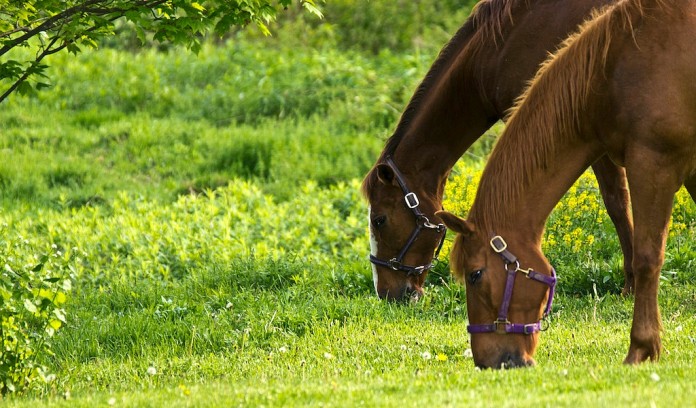Spring is here, and the plants are new and fresh. The pretty, lush grasses that green the countryside in April and May are young, tender, and very tasty for a horse. Unfortunately, these young grasses are also low in the fiber that horses need and are high in the soluble carbohydrates that can upset the sensitive microbiotic balance in a horse’s gut.
Equine veterinarians at the University of Illinois Veterinary Teaching Hospital in Urbana say that, since horses are natural grazers, they need a diet high in fiber such as that found in long-stemmed, mature forage grasses.
Grass balance
Young grasses are higher in soluble carbohydrates. Large amounts of these carbohydrates can overload the gut, disturbing the balance of natural bacteria.
As large numbers of natural gut bacteria die, they release a surge of a bacterial toxin called endotoxin and factors that may trigger laminitis.
Various sicknesses
The alterations in gut flora and release of trigger factors can cause acute signs of laminitis in predisposed horses, such as overweight horses, horses with a previous history of laminitis, and horses with Cushing’s disease.
Forage management is the best way to prevent this problem, called “grass founder.” Experts at Illinois say owners should not overfertilize and should not allow grasses to go to seed.
Some grasses, such as southern grasses, form seed heads quickly, and horses will graze and pick for these tasty, high-carbohydrate seeds. If forage management is not feasible, owners should keep horses away from young grasses in April and May, when the grasses are most rich in carbohydrates.
It can be difficult to keep horses from eating these grasses, but confining horses to a dry lot is one option. If a horse is let out to a green pasture, a muzzle can keep it from grazing the sweet grasses.
As grasses mature and become more “stemmy,” their fiber content increases and their carbohydrate content drops, thus the risk for grass founder decreases as summer approaches.
Fescue toxicity
Another common problem with spring grasses is fescue toxicity. Fescue is a native grass prevalent in the central United States, and many varieties are widely grown as lawn grass and sold in garden stores.
Fescue is popular because it is considered a “wonder grass:” it’s disease resistant, it’s drought tolerant, and it resists insects and temperature extremes.
The secret behind fescue’s hardiness lies in the fungus that lives inside it. Unlike the fungi that commonly grow on the outside of grains, the fescue fungus grows inside the plant and is passed on through the seeds.
This fungus produces an ergot-like alkaloid, which is toxic to many animal species. In horses, fescue toxicity can cause reproductive problems.
Fescue alkaloids can delay a mare’s estrus cycle. Also, they prolong pregnancy by blocking the hormones that initiate labor, so a pregnant mare may carry a fetus for up to 14 months instead of the standard 11 months.
Foaling after such a prolonged pregnancy can be difficult, since the fetus is larger than normal and the mare doesn’t have the hormones to relax the pelvic ligaments for delivery.
Additionally, fescue can suppress prolactin, the hormone responsible for milk production. Fortunately, fescue toxicity is reversible; if a horse is off fescue pasture, she can clear the toxin within a matter of days.
For mares that have had a prolonged pregnancy, certain pharmaceuticals can help reverse the action of fescue alkaloids, helping to induce labor.
For more information about grass founder or fescue toxicity, contact your local equine veterinarian.










